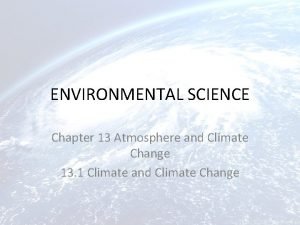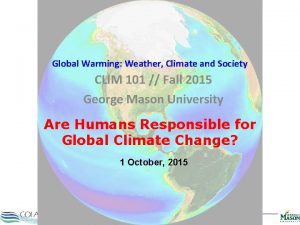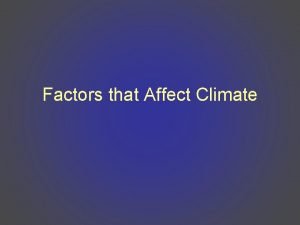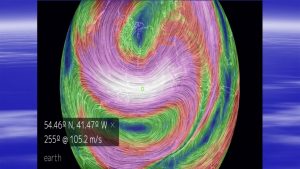Climate Weather and Climate Latitude and Climate Landforms





- Slides: 5

Climate: Weather and Climate Latitude and Climate Landforms and Climate People and Climate

Weather and Climate: Atmosphere: layers of air (gas) that protect the Earth (1, 000 miles thick). Weather patterns are found in the layer of the atmosphere closest to the Earth. Weather refers to the unpredictable changes in air that take place over a short period of time. “It is sunny outside today. ” When you talk about patterns of weather you are talking about climate. “What is winter like in Florida? ” describes climate. Climate refers to the usual, predictable pattern of weather in an area over a long period of time.

Latitude and Climate: The sun is the original source of climate. The sun’s rays warm the land, water and gases. Warm gases and liquids are lighter than cool gases and liquids, because they are lighter they rise. Climate is also affected by the angle at which the sun’s rays hit the Earth. The sun shines most directly on the equator. The Tropics, area around the equator , receive the sun’s most direct rays and experience a hot climate. Outside of the Tropics, the sun is never directly overhead. Areas north and south of the Equator receive indirect rays from the sun. When the North Pole is titled toward the sun (remember axis and 23 ½⁰ ), the sun’s rays fall more directly on the Northern Hemisphere giving us warm summer days. When the South Pole is titled toward the sun, the sun’s rays fall more directly on the Southern Hemisphere. People living in the Northern Hemisphere receive indirect rays and experience fall and winter. The shape of the Earth and the angle of the axis means that the Poles are always cool or cold.

Landforms and Climate: The higher the elevation of a place the cooler the climate. In high mountains, air becomes thinner and cannot hold as much heat from the sun; temperature drops. Even in the Tropics, snow covers the mountain tops. When warm moist from the ocean blows up a mountain the air cools as it rises. As the air becomes thinner and cools it looses moisture and rains or snows. Climate on the windward – wind facing – side of mountain ranges is moist and often foggy. Trees are thick and green. By the time the air moves over the mountain peaks, it is cool and dry. This creates a rain shadow or dry area on the side of the mountain facing away from the wind – leeward side. The dry air warms as it moves down the mountain giving the region a dry/desert climate.

People and Climate: Cities are generally warmer than rural areas. Buildings and streets absorb more heat than plants and trees. Also, people burn coal, oil and natural gas for energy (and heat in the winter). Some scientists warn that burning these fuels releases gases in the air creating a greenhouse effect which prevents the warm air from escaping into the atmosphere. As a result, these scientists believe the overall temperature of the planet is increasing. Global Warming is currently being studied and debated. Rainforests are also being destroyed for lumber and farmland. The unused trees and shrubs are burned adding to the greenhouse effect. In a rainforest, the sun’s rays do not hit directly on the forest floor creating a warm moist climate. Moreover, when rain falls on the trees it is evaporated and the water cycle continues. Scientists worry that cutting down the trees could lead to more direct sunlight, less evaporation and eventually an arid/desert climate.









